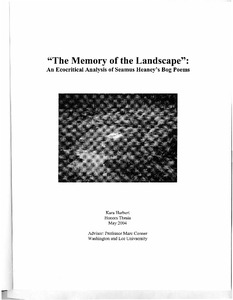| dc.description.abstract | What is the relation between the poet and nature? How is the inspired linked to this natural inspiration? These are among the questions that brought forth the creation of Ecological Criticism, or ecocriticism, a theory of analysis that examines this very relationship. Yet, the recent concept of ecocriticism has changed over the years. Steven Rosendale puts it most concisely: "Environmental literary criticism is at something of a crossroads."[1] What was once used strictly to study nature writing-writing that asserts the intrinsic value of the environment-now applies to literature that provides a much wider definition of environment. Today, ecocriticism reaches well beyond the confines of nature writing and analyzes a wide range of literature whose definition of environment is rural and urban, wild and cultivated, nonhuman and human.[2] This last distinction is perhaps the most crucial in understanding an author's treatment of the land, for traditional nature writing, which served as the original subject and progenitor of the ecocriticism movement, defines the environment in its own terms -- necessarily non-anthropocentric. . . . In this thesis, I use ecocriticism as a means to understand the complex relationships that exist in Heaney' s bog poems: the relations between nature and culture and between history and mystery. I argue that Heaney' s selection of a complex environment, the bog, allows for the development of binaries -- nature and culture, history and mystery -- into necessarily conflated elements. Chapter One demonstrates how Heaney characterizes the bog and in tum uses the bog as a defining element of Ireland's cultural landscape and identity. Chapter Two illustrates that the bog serves as a portal to history, but at the same time lends to the development of surrounding mystery. The
objects and bodies are evidence of both -- they are hard evidence of a factual, historical past, but their obscure origins and past lead the reader and poet to fill in spaces with mystery. Chapter Three explores the notion of the bog as embodied, as I argue that through his Bog Poems, Heaney develops the bog in such a way that it becomes a character in the poems and not simply a location. Doing so reasserts the relationship between nature and culture, as a nature-character necessarily becomes part of the culture, both in the time-place-scapes and in the poems. Likewise, the representation of the bog in poetry also becomes a body. Chapter Four develops the idea of the poet as bard, for it is through the words of the poet that the translation of one time-place-scape to the next is possible. As the original bard figures gave distinct language to history and mystery, Heaney as the poet gives voice to history as it is preserved in the bog and mystery as it is provoked by objects from the bog. Finally, as the bog literally gives rise to objects that suggest history and provoke mystery, so does the poet give rise to poems, which themselves become objects of history and mystery for the reader. In the conclusion, I discuss the position of Heaney as poet, and how he is implicated in his own poetry, unable simply to serve as a translator. [From Introduction] | en_US |
| dc.rights | This material is made available for use in research, teaching, and private study, pursuant to U.S. Copyright law. The user assumes full responsibility for any use of the materials, including but not limited to, infringement of copyright and publication rights of reproduced materials. Any materials used should be fully credited with the source. | en_US |
